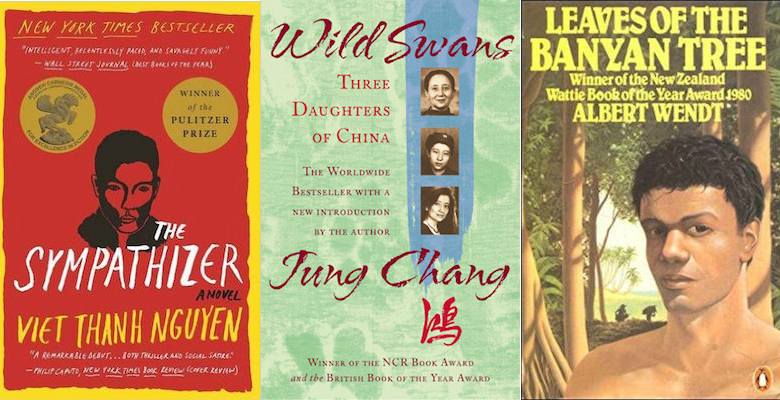Asian/Pacific American Heritage Month was first celebrated in May of 1990. Since then, the achievements and contributions by these communities have been commemorated each year. An important part of any culture are the stories, legends, and tales that have been carried from generation to generation, which stand as the cornerstone of these cultures and reflect the different histories that have shaped the communities into what they are today. Below is a list of 10 books to read this month (or any month), to learn the history and stories of Asians and Pacific Islanders, and celebrate the authors that write them.
¤
Wild Swans by Jung Chang
Chang recounts her family history, spanning three generations of Chinese women. She details the story of her grandmother, who was forced by her father to be a wealthy general’s concubine. After the general dies, she flees with Chang’s mother, who grows up to be a well-respected member of the Revolution and Mao Zedong’s army. It is a riveting story that details not only the communist history of China, but the hardships women faced during the era.
When the Emperor Was Divine by Julie Otsuka
Otsuka’s debut novel is a detailed historical fiction told from the perspective of four family members taken to a Japanese internment camp. The story follows the family’s eviction from their home in California, the train ride to camp, through their experience there, and their lives after living in the camp. When the Emperor Was Divine leaves a haunting and resonant lesson on the mind.
Leaves of the Banyan Tree by Albert Wendt
Wendt is a celebrated Samoan author who has written over 20 books about the Pacific. Leaves of the Banyan Tree follows the story of Tauilopepe, the matai (high chief) of his village. The novel illustrates the push and pull between old, traditional ways of life, and the westernization of the economy and the island.
The Interpreter by Suki Kim
The Interpreter follows a Korean woman after her parents are murdered in the bodega they owned and she helped manage. Kim explores the perspective of a first-generation Korean-American caught between two cultures.
“Princess Hina and the Eel,” a Tongan legend
“Princess Hina and The Eel” is an age old tale in Polynesian history. The Tongan version lends itself to be the most romantic because of its royal aspect. The Kingdom of Tonga is as old as the island, and traditionally, kings and queens are supposed to marry someone in the family, to keep bloodlines pure. In this story, Princess Hina becomes pregnant, and refuses to tell her father who her unnamed lover is. When her father finds out her lover is a common man, he names him “Eel.” Legend has it that after Eel is put to death, he gives Hina, and the rest of the world, an amazing gift. He tells Hina to cut off his head once he is dead and bury it into the ground. Weeks after his request is fulfilled, the Pacific’s first coconut tree begins to grow in the spot where his head lies. It is a tale of a fruitful love that knows no bounds.
The Sympathizer by Viet Thanh Nguyen
The 2016 Pulitzer Prize winner for fiction, The Sympathizer tells the story of a half-Vietnamese half-French communist double agent who lives with other Vietnamese refugees in Los Angeles after the Fall of Saigon. While building his new life in America, he is secretly reporting back to his communist leaders in Vietnam. His efforts to survive in two different worlds lead to his demise at the hands of someone he trusts the most.
Untouchable by Mulk Raj Anand
Anand’s first novel depicts the life of Bhaka, a young “untouchable,” the lowest rank in the Indian caste system. After being banished by his father and being hated by everyone, a downtrodden Bhaka finds himself listening to the inspirational words of Ghandi, who is speaking about the plight of the “untouchables” and his life mission to see them free. Though he never moves through the caste system, his reluctant acceptance of his status is tragic. Bhaka’s story is used to make a case against the caste system, allowing readers to understand a day in the life of an untouchable person.
Unfamiliar Fishes by Sarah Vowell
This is the only book on this list that wasn’t written by a member of the community that the novel is about. Vowell was traveling in Hawaii and found the story of musician and monarch Liliuokalani heartbreaking, and began to research Hawaiian history in depth. She recites her findings in this work of nonfiction. It travels from the first ship landing on Hawaiian sand to the last Queen, who fought tooth and nail to keep her islands truly Hawaiian.
The Whale Rider by Witi Ihimaera
A contemporary rewriting of an ancient story, Ihimaera depicts the struggle between an ever-changing world, and perpetual traditions. She tries her best to earn the approval of her great-grandfather, the chief of her Māori village, but he is unimpressed by any of her actions. Only after she literally follows the footsteps one of her ancient ancestors does he consider changing his mind.
The Joy Luck Club by Amy Tan
Four Chinese immigrants living in San Francisco begin meeting to eat and play mah jong, calling themselves the Joy Luck Club. Tan explores the relationships between these four women and their American-born children in tender and heartbreaking ways. The meetings provide a safe space for the women to gush about their current lives, and the lives they left behind in China. Though it is centered around the immigrant experience, it also illustrates each generation’s search for self.


